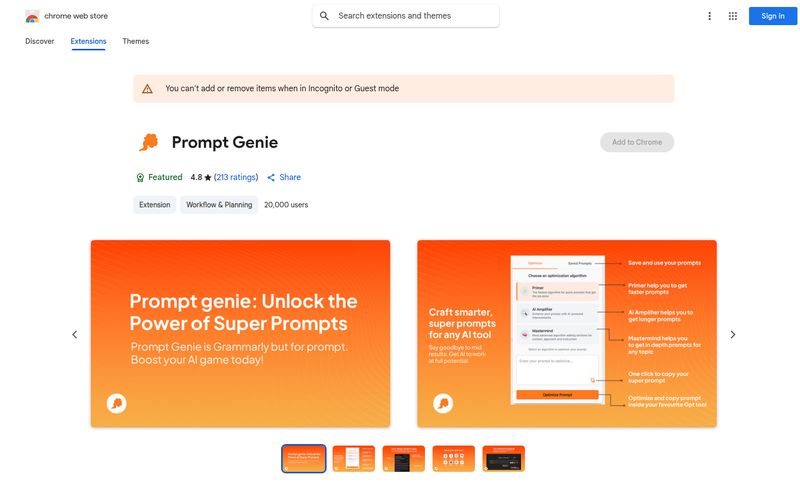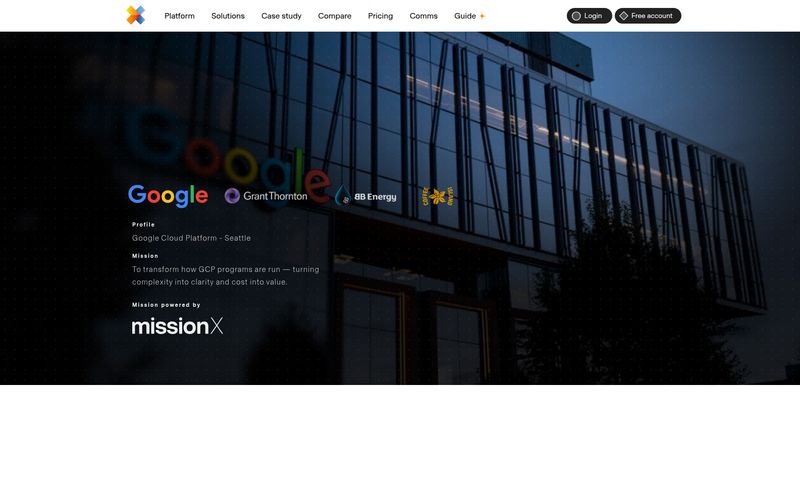If you're in a startup, you know the drill. A new hire, let’s call her Jane, starts on Monday. Your Friday afternoon is now a frantic scavenger hunt through a dozen different SaaS platforms. “Okay, she needs Slack… Asana… Figma… Mailchimp… that weird analytics tool Dave signed up for last month… what was the password for that again?” It’s chaos. Pure, unadulterated, password-resetting chaos.
And offboarding? Even worse. It’s a security hole waiting to happen. Did you remember to revoke access to everything when that freelancer’s contract ended? Are you sure? Like, 100% sure?
I’ve been there. My credit card has been there. My blood pressure has definitely been there. We're all drowning in a sea of monthly subscriptions and forgotten user accounts. It's the wild west of IT management, and most startups don't have a dedicated sheriff. This is the exact kind of mess a tool like AppManager claims it can clean up.

Visit AppManager
So, What's the Big Deal About AppManager?
At its core, AppManager pitches itself as an AI-powered IT sidekick specifically for startups. Think of it as a centralized dashboard for all the messy, time-sucking IT tasks that nobody wants to do but everyone needs done. It’s designed to handle user management, app provisioning, subscription tracking, and permission controls from one single spot.
Instead of logging into ten different services to add or remove a team member, you do it once. Instead of wondering what you’re paying for, you get a clear breakdown. It's not just about convenience; it’s about reclaiming sanity and plugging financial leaks you didnt even know you had. In a world where every dollar and every minute counts, that’s a pretty compelling argument.
Taming the SaaS Beast: A Look Under the Hood
Okay, the sales pitch sounds great. But as we all know, the devil is in the details. What does AppManager actually do? Let's break down some of its core features.
Finally, Centralized User & App Onboarding
This is the big one for me. The idea of having a single process to grant a new employee access to all their necessary tools is… well, it’s beautiful. No more juggling tabs or searching for that one admin login. AppManager aims to streamline this entire user provisioning process. You can create roles, assign apps to those roles, and get a new team member up and running in a fraction of the time. This isn’t just an efficiency play; it’s about creating a better, less-frustrating first-day experience for your new hire.
Solving the Offboarding Headache
The flip side of onboarding is even more critical. Proper user deprovisioning is a massive security concern. A study by CyberArk will tell you horror stories about ex-employees retaining access to sensitive data. AppManager provides a kill switch. When someone leaves, you can theoretically revoke all their permissions and app access from one central control panel. This single feature could be worth the price of admission for any founder who's ever woken up in a cold sweat wondering about lingering access.
Where on Earth is All the Money Going?
Ah, the classic startup mystery. A credit card bill arrives with a dozen cryptic charges for services you vaguely remember signing up for. AppManager brings this into the light with its Subscription Management and Employee Cost Breakdown features. It gives you a bird's-eye view of your entire SaaS stack, what you're paying for, and even breaks it down by employee. Those “Smart Spending Insights” sound particularly interesting. You might discover you’re paying for 20 licenses of a tool that only 5 people actually use. That’s instant, actionable savings.
Who Has the Keys to the Kingdom?
Managing who can do what within each application is another time-sink. With its Permissions Management, AppManager helps you control user roles and access levels across different platforms. This ensures that an intern can't accidentally delete your entire customer database (we've all heard the stories). It's about enforcing the principle of least privilege without having to become a power-user in every single app your company uses.
The Good, The Bad, and The… 404 Error
No tool is perfect, and it’s important to look at this with a critical eye. On one hand, the benefits are clear. You get simplified management, potentially huge time savings, better security posture, and real visibility into your SaaS spend. For a lean startup, that’s a powerful combination.
"Giving a small team a tool like this is like giving them an IT department without the overhead. It lets them focus on building the product, not managing software logins."
However, there are a couple of things to consider. The provided info suggests the pricing is on a per-employee, per-month basis. This model is pretty standard for SaaS management platforms like Rippling or Zluri, but it can get pricey as your team scales. What’s affordable for 10 people might be a serious budget item for 50.
And now for the elephant in the room. When I tried to check the pricing page for specifics… it returned an error. Yep, a 404. Look, it happens. A bug, a deployment issue, who knows. But for a company selling IT management and stability, it’s not a great first impression. It makes it impossible to give you a concrete cost analysis, which is frustrating. Transparency is everything in this space.
So, How Much Will This Magic Set You Back?
This is the million-dollar question with, currently, a shrug of an answer. Without a working pricing page, we have to speculate based on the industry. Tools in this category can range from $5 to $20+ per user per month, often with different tiers of service.
My gut feeling? AppManager is likely targeting early-stage startups, so they might have a more competitive, entry-level price point. But the per-employee model means you need to do the math. If it saves each employee an hour of hassle per month and prevents one costly subscription over-run per quarter, it probably pays for itself. You just have to weigh that potential ROI against a currently unknown hard cost.
Who Is AppManager Really For?
Based on its feature set and positioning, AppManager seems tailor-made for a specific profile:
- Seed to Series B Startups: Companies that are growing fast enough for IT to become a problem, but not big enough for a dedicated, multi-person IT team.
- Non-Technical Founders: If the person managing everything is the CEO or COO, a tool like this can offload a ton of technical debt and mental overhead.
- Companies with Remote or Hybrid Teams: Managing app access for a distributed workforce is exponentially harder. A central platform becomes almost a necessity.
If you're a larger enterprise with an established IT department and complex compliance needs, this might be too simplistic. But if you’re in that chaotic, beautiful growth phase, this is exactly the kind of solution you should be looking at.
Frequently Asked Questions
- 1. Is AppManager only for tech startups?
- Not at all. While it's positioned for startups, any small to medium-sized business that uses a variety of SaaS applications (think marketing agencies, design studios, consulting firms) could benefit from centralized management.
- 2. How exactly does AppManager improve our security?
- The two main ways are through streamlined deprovisioning and permission control. Ensuring ex-employees immediately lose access to all company data is a huge security win. Plus, managing permissions from one place reduces the risk of someone having more access than they need.
- 3. What's the real value of tracking employee app costs?
- It's about eliminating waste. You can identify “shelfware”—software you pay for but nobody uses. You can also spot redundancies, like paying for three different project management tools. This visibility leads directly to cost savings.
- 4. How difficult is it to set up and integrate?
- While I haven't used it personally, tools like this are designed for simplicity. The value proposition is saving time, so a complicated setup would be self-defeating. Expect a guided onboarding process that involves connecting your various SaaS accounts via API keys.
- 5. Are there alternatives to AppManager?
- Yes, this is a growing space. Some well-known players include Rippling, Zluri, and BetterCloud. Each has its own strengths, with some focusing more on HR integration and others on pure IT automation. It's wise to compare a few options.
- 6. What should I do about the broken pricing page?
- If you're genuinely interested, I'd recommend reaching out to their sales or support team directly for a demo and a quote. While the broken page is a hiccup, a direct conversation will give you the most accurate information.
My Final Take
The problem AppManager is trying to solve is very, very real. The pain of SaaS sprawl and manual IT management is a silent growth-killer for many startups. The promise of a single, intelligent platform to manage it all is incredibly appealing.
Despite the fumble with the pricing page, the core concept is sound. Centralizing user management, controlling costs, and tightening security are not just 'nice-to-haves'; they are critical for scaling a business responsibly. If you’re a founder or an operations lead who feels like they're spending more time as a de-facto IT admin than on their actual job, AppManager is definitely a name to keep on your radar. I'd say it's worth bookmarking and checking back on once they've sorted out their website glitches. The right tool here could genuinely give you back your Friday afternoons.
Reference and Sources
- CyberArk: The Importance of Employee Offboarding to Organizational Security
- Rippling: A popular competitor in the workforce management space.
- G2: Category of SaaS Spend Management tools for comparison.



